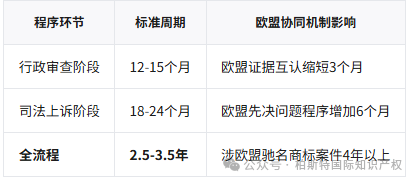- Knowledge
Romania
Trademark opposition system

one
Romania
Trademark opposition acceptance agency


Romania implements a dual track administrative judicial jurisdiction system:
1. Administrative supervisory authority
Objection Division of China National Intellectual Property Administration (OSIM): responsible for form review, evidence review and preliminary adjudication
Industrial Property Dispute Committee: composed of legal and technical experts, handling complex cases for review
2. Judicial Authority
Those who are dissatisfied with the administrative ruling can appeal to the Bucharest City Court
Final appeal can be made to the Intellectual Property Division of the Romanian Supreme Court (established in 2022)
Special requirements for agents:
Applicants within the European Union may entrust an EU registered lawyer to represent them
Non EU applicants must submit their application through a member of the Romanian Association of Patent Agents (ORIR)
Non Romanian language documents require authentication and translation by the Ministry of Justice (Chinese documents require dual authentication: Embassy of Romania, Ministry of Foreign Affairs of China)
objection to a trademark

two
Romania
Timing of Trademark Objection


Romania implements EU standard objection period:
1. Official announcement period
After substantive examination, the trademark will be simultaneously announced on the OSIM official website and the EU Trademark Gazette for 3 months
Objection applications must be submitted electronically (EET time zone) before 24:00 on the announcement deadline
2. Supplementary Objection Period
Within 5 years after trademark registration, supplementary objections can be filed based on malicious registration (with an additional fee of 1500 lei)
3. Grace rule:
Can apply for a maximum extension of 30 days (with a daily surcharge of 100 lei, approximately 20 euros/day)
Force majeure requires notarized proof documents (such as an emergency declaration issued by the embassy)
objection to a trademark

three
Romania
Basis for Trademark Objection Application


According to Articles 6, 7, and 14 of the Trademark and Geographical Indication Law and EU Directive 2015/2436, the statutory grounds for objection include:
(1) Absolutely prohibited reasons
1. Lack of significance
Only composed of the generic name or purely descriptive identification of the product (such as the traditional cheese name Br â nz ă de burduf)
Unauthorized use of EU registered geographical indications (such as the Romanian wine region of Dearu Mare)
2. Violation of public order
Contains national emblems, Eastern Orthodox symbols, or content that violates the EU Charter of Fundamental Rights
(2) Relative prohibited reasons
1. Prior conflict of rights
Confusion with registered trademarks in Romania/EU for identical or similar goods (Nice Classification 12th edition)
Copy unregistered trademarks that are well-known within the European Union (sales data for the Balkan market must be provided)
2. Commercial identification rights
There is substantial similarity with the registered trade name (CUI number) in Romania
3. Malicious registration by agents
Unauthorized registration of the principal's trademark by the agent (subject to Article 18 of the EU Trademark Regulation)
(3) Special protection reasons
1. Traditional product labeling
Infringement of Romanian traditional product names (such as 259259259259259259259259ă lig259ă Congee)
2. Internet keyword infringement
Registering someone else's trademark as a search engine advertising keyword (established by Bucharest court case in 2021)
objection to a trademark

four
Romania
Trademark opposition process


Stage 1: Electronic submission (0-1 month)
Submit a statement of objection (in Romanian) through the OSIM electronic platform (e-OSIM)
Please attach:
Proof of prior rights authenticated by The Hague
Evidence of actual use of the trademark (including invoicing records for Romanian VAT numbers)
EU Market Monitoring Report (when applicable to well-known trademarks)
Payment fee: 1200 lei (approximately 250 euros)
Stage 2: Formal review (1-2 months)
OSIM will complete the review within 15 working days. Common correction requirements include:
Supplement the commodity circulation certificate issued by the Romanian Chamber of Commerce
Update the certification of the European Bar Association for the power of attorney
Stage 3: Substantive defense (3-5 months)
The opposing party shall submit a defense statement within 60 days (with the option to apply for a 30 day extension once)
Simultaneously submit a trademark usage plan (certified by a notary office)
Stage 4: Evidence Exchange (5-9 months)
Both parties shall submit up to three rounds of evidence (with a 45 day interval between each round)
Accept the EU unified evidence format (such as eEvidence XML standard)
Stage 5: Hearing Procedure (9-12 Months)
The Industrial Property Dispute Committee organizes a video hearing (electronic evidence package must be submitted in advance)
Both parties shall submit a technical comparison report (not exceeding 50 pages, bilingual version)
Stage 6: Administrative adjudication (12-15 months)
Possible ruling outcome:
Completely revoke the opposed trademark (2023 data shows a success rate of 38%)
Request for additional differentiation explanation (such as adding regional qualifiers)
Reject the objection application
Stage 7: Judicial relief (15-30 months)
The losing party may appeal to the Bucharest Court (deadline is 30 days)
The average trial time of the Supreme Court is 18-24 months
objection to a trademark

five
Romania
Trademark opposition period



Time optimization tool:
Fast track: Provide 9-month acceleration program for small and medium-sized enterprises (annual turnover<1 million euros)
Suspension mechanism: If both parties reach a settlement intention, the procedure can be suspended (with a maximum freeze of 18 months)
Practical operation suggestions
1. EU collaborative monitoring
Real time tracking of trademark announcements in Southeast Europe using the EUIPO TMview
Registering a Romanian trademark while applying for an EU trademark (reducing opposition costs)
2. Evidence chain reinforcement
Provide sales records certified by Romanian tax authorities (including CUI code)
Social media evidence needs to be notarized during the access process and accompanied by a Romanian language abstract
3. Cultural Compliance Strategy
Avoid using protected expressions such as' tradi ț ional 'in food trademarks
Religious trademarks require prior consultation from the Eastern Orthodox Affairs Bureau
4. Cost control plan
Apply for EU Intellectual Property Fund (EIF) subsidies (covering up to 50% of official fees)
Adopting a segmented payment model (30% initial hearing, 50% final results, 20%)




